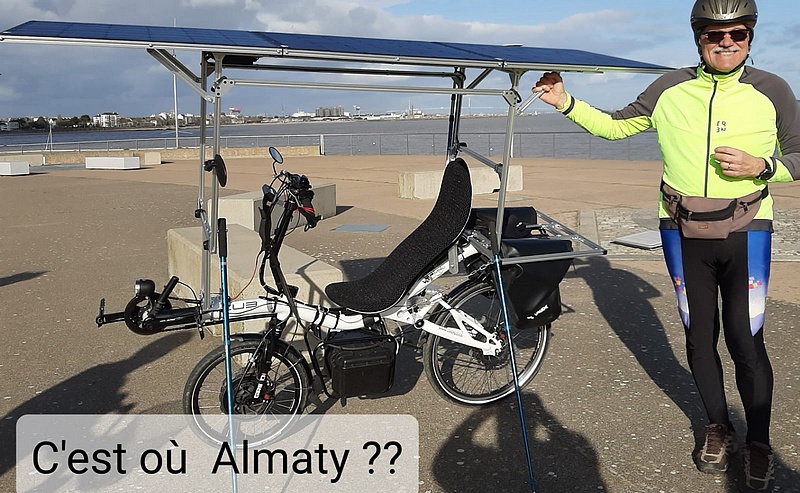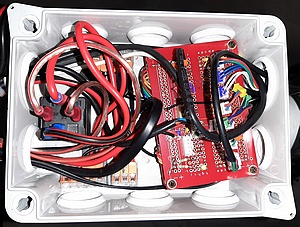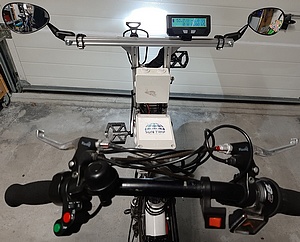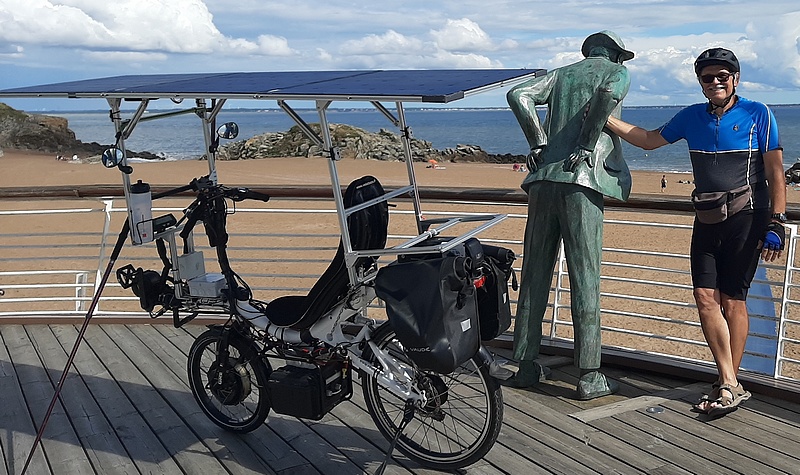
Introduction
I built my first electric bike in 2007, the second in 2016, a Decathlon Rock Rider 5.3 mountain bike.
In 2018, I attended the start of the Lyon-Canton Sun trip and I was stunned, amazed, excited. I followed the participants from Lyon to Chamonix, took dozens of photos. When I got back, I started thinking about building my first solar electric bike.
Having little technical information, I had searched on the internet for several weeks for the equipment that could suit me. I had chosen an older model Nine Continent RH205 engine, sold with a controller and a P.A.S., a 48 V 17.5 Ah battery, a trigger, two brake handles with contact.
To make the Sun Trip 2019, I had associated with my Rock Rider an AEVON STD 100 trailer that carried a rigid solar panel of 300 Wc. But the panel alone weighed 18 kg. A little too heavy for my taste!
In the perspective of a Lyon-Canton Sun Trip in 2020, I decided to equip myself with a fully suspended Azub Six recumbent bike.
Technical description
Cycling
Azub Six Recumbent Bike fully suspended:
- 20'' front wheel
- 26" rear wheel
- Rear wheel equipped with an Enviolo 380 variator.
Motorization

- Grin Technologies Direct Drive front wheel motor,
- Phaserunner Controller
- Cycle Analyst V3
- 1 Arduino driving supervisor of my manufacture allowing me to finely adjust the speed, the power of the Grin Technologies engine
The battery
Battery 48 V – 22.5, Ah
The solar roof
Solar panels
- 3 Solar panels of 36 cells 120 Wc Sun Travel. Dimensions: 2.40 m long and 80 cm wide.
- 3 MPPT 300 W solar controllers.
Load-bearing structure
The entire structure is made of 20 x 20 profiles and assembly parts (System).
Accessories
- DC-DC 48V >12V power supply to power USB accessories and chargers
- Powerful white lighting at the front
- Red rear lighting
- 2 red flashing lights at the rear and white at the front.
Feedback
Balance on a recumbent bike
I had a lot of balance problems at first. A recumbent bike is not driven in the same way as an upright bike. Basically the handlebars are only used to have a point of support of the hands and especially not to control the direction of the bike. In the turns it is necessary to tilt and with the mass of the solar panels in height, it is necessary to control its degree of inclination. And keep its speed constant. Otherwise the fall can happen. To pedal effectively and have good balance control, you need to have your buttocks and back firmly on the seat.
I fell of course several times, mostly stationary, but the robust and somewhat heavy construction of the cage supporting the solar generator, allowed me to collect only a few scratches and especially to keep intact the integrity of the solar panels. My bike simply lay on its side without suffering any major damage other than the loss of a rearview mirror.
Positives
Trigger (throttle)
Starting a recumbent bike loaded at more than 150 kg is an impossible mission without electric assistance. Also, the trigger seemed essential to me at the start.
Ergonomics

I chose to put the control of my Enviolo drive to the right of the handlebar and everything related to the electric controls of the Grin Technologies motor to the left of the handlebar (trigger power and speed control). It is the small Arduino supervisor programmed by me who centralizes all these commands from the handlebars, the solar shunt and the Cycle Analyst v3. It then transmits, through the speed and power control, this information to the analog inputs of the Cycle Analyst. All such orders are subject to the PAS of the bike. This arrangement allows me to quickly apprehend any change in driving, stop, start acceleration braking etc. while instantly having the right gear of my bike.
Consumption
I drive most of the time between 20 and 30 km/h (30 when the wind pushes me or downhill). It is in this speed range that the engine has the best performance. My average consumption is 12 to 15 Wh/km. It can go below 10 Wh/km with regeneration on descents, if the bike is not too loaded.
The max power of my bike is limited to 750 W. It automatically regenerates at 35 – 40 km/h on slopes. If I activate the electric braking below 35 km/h, the regeneration produces 200 to 350 W that recharge the battery. This is a key advantage of Direct Drive engines.
The evolutions of my bike
In 2021, on my Azub Six Version 2, I experimented with the addition of a 2nd motor (Bafang BBS02 of 750 W) and a 2nd battery of 48 V 17.5 Ah. The batteries have a total capacity of 40 Ah, or about 2 kWh, which greatly increases the range!
I built a new Aduino driving supervisor to control power and speed and also allows to distribute the load between the 2 motors or to control them separately. It is with this bike that I participated in the Breizh Sun-Trip 2021.

